Introduction
Different kinds of sweeteners such as natural and artificial ones have been used to make a cake with the reduced amount of sugar. Effect of Polyols and aspartame as the replacements for sucrose on a spongy cake’s properties showed that replacing sucrose with a Polyols can decrease the size, porosity and bulk density of a cake.1 Replacing sucrose with aspartame and sorbitol has decreased the cake’s calorie to 24%.2 Further, the use of sorbitol as an alternative sweetener to sucrose in the formulation of cookies was investigated and a product with soft tissue was made.3 The reduced-calorie cookies were produced because of replacing sucrose with sorbitol, fructose and mannitol in another study.4 In addition, replacing sucrose with mannitol, sorbitol and fructose as well as investigating the replacement impact on the cake properties indicated a decrease in calories, and the amount of calories was decreased by increasing the percentage of sucrose as a replacement for these sugars.5
Production of folic acid and iron-fortified biscuits and their impact on the biscuit physic-chemical properties was assessed by replacing the grape juice concentrate with the sugar. The results indicated that replacing grape juice concentrate with the sugar had a significant impact on the physic-chemical properties, as it decreased pH and increased the content of ash and moisture in addition to increasing the shelf life of biscuits.6
Further, the possibility of replacing sugar with grape juice concentrate in a traditional sweet named “Halvay-e Shire” was investigated. The results indicated that the grape juice concentrate can be used as an appropriate replacement for the sugar in “Halvay-e Shire”.7
With regard to the properties of tagatose, the study identified tagatose as a low-calorie sweetener having a low absorption and a taste quality similar to sucrose.8 The study show that the effect of tagatose and inulin on a dark chocolate and concluded that the acceptability rate of cookie increased as the amount of tagatose and inulin increased and reduced, respectively.9 In another study, focused on the storage stability of tagatose in the solutions including various combinations, the results indicated that a small amount of Tagatose has been lost during the storage phase, and the reaction of Millard has happened in the 0.02 M Phosphate Buffer and Citrate solution with a pH of = 3.10 Gilbert, in his study, entitled as “Tagatose as a Sweetener of GRAS and Healthy Product” in 2002, concluded that Tagatose is a natural, bulky and low-calorie sugar, which it has been confirmed by FDA and can be used as a sweetener in foods and beverages. It also provides the requirements for a low-calorie sweetener in the products such as chocolates, gums, cakes and confectionary products, ice creams and foods containing cereals, in which the amount of sugar is very important.11 Katherine and Luecke12 investigated the thermal stability of Tagatose in solutions and indicated that the minimum amount of Tagatose was lost at a pH =3 and a negligible amount of brown color was observed in which its level of wastage was increased at a pH =7.
In another study, Stevia was regarded as a good replacement for sucrose to make the products such as cakes, biscuits, beverages and juices, due to its high sweet properties and health benefits.13
In this research, effect of the natural sweetener (grape syrup) as a replacement of sugar in production of sponge cake, chemical and sensory attributes have been studied.
Materials and Methods
The ingredients were prepared from a market for making cakes including flour, oil, sugar, baking powder, water, eggs, vanilla and grape syrup. Further, in order to perform the research, following instruments were used: An Electronic digital weight scale, with an accuracy of 0.01gr (SF-400 made in China), Metal mold (made in Iran), 150-watt power Katomo electric mixer (HA-3020 made in Japan), Sartorious Moisture meter (MA-35 made in Germany), Hunter Lab colorimeter (color flex made in U.S), An Taksan oven for cooking (5101, made in Iran). Aw sprint (Novasina made in Switzerland).
Production Method
In order to make a spongy cake, the grape syrup at the five levels of 0%, 25%, 50%, 75% and 100% were replaced with the sugar in the formulation of cake. 72% sugars, 57% oils, 0.5% vanilla, 72% eggs as well as 1.34% baking powders and 25% water (according to the wt% of water) were used as the ingredients of this formulation. Then, the batter was poured into a mold and cooked in a preheat oven to 180 ˚C for 30 minutes. In the next stage, the samples were cooled at the room temperature for 3 or 4 minutes, covered by the cellophanes and finally kept at an ambient temperature after being removed from the molds.
In the present research, the samples for the chemical test were examined based on three replicates on the first day of production, and sensory evaluation, they were tested on the first and seventh days of production based on three replicates for each of the days.
Moisture measurement
In order to measure moisture, The cake samples were placed in an aluminum container in a device for weighting and the device was set based on the desired temperature and time (110˚ C and 40 minutes). In the next step, the moisture was measured by the device through the weight discrepancy, caused by drying. The moisture content of cake was measured at 110˚ C during the first and seventh days after baking.14
Protein measurement
The crude protein of grain and its products were measured according to the (ISIRI).15
Sugar measurement
Sugar was measured based on the third revision made according to the (ISIRI).16
Peroxide value of the extracted fat
In addition, the peroxide value of the extracted fat was measured according to (ISIRI).17
Acidity of Extracted Fat
In order to measure the acidity of the extracted fat, according to the (ISIRI).17
Aw measurement
Regarding Aw measurement, we first set the device based on the ambient temperature (25˚ C). Then, we put the samples into a Novasina Sprint aw unit and recorded the values of aw.
pH measurement
In order to measure pH, 10 gr of the sample was completely mixed with 100 ml of the freshly boiled distilled water and was left to be settled. Next, the pH for the upper solution (without being filtered) was determined with an electronic pH meter, which was adjusted to the Buffer solution according to the solution’s pH.17
Acid-insoluble ash measurement
In another stage, the acid-insoluble ash was measured based on the (ISIRI).17
Color measurement
L*, b* and a* factors as well as the tissue of samples were measured and recorded through a Hunter Lab Colorimeter in order to evaluate the color of the cake. First, the device was calibrated, by which the values of calibration were as follows: L* = 92.23, b* = 1.19 and a* = -1.29. Then, the samples were placed into the device and the values of L*, b* and a* were recorded for each of them. The factors L*, a* and b* represent the lightness, the contour between red and green and the contour between blue and yellow, respectively. It is worth mentioning that three replicates were made for all the above values to determine the mean.
Sensory evaluation
In the present study, an organoleptic testing method (sensory) was used. In this experiment, five assessors were asked to participate in the acceptable test. They were requested to provide their suggestions and comments on the sensory properties of the cake, such as taste, oral sense, apparent color, the minimum rate of adhesion and overall acceptability, and score them from zero to ten. From 1(dislike extremely) to 10 (like extremely). A special form was used for the sensory assessment whose the score range was varied between zero and ten.
Statistical analysis
In this study, the tests were conducted on the firmness, moisture and color indexes using a factorial experiment and completely randomized design (CRD) with two factors of treatment (at 5 levels) and time (at 2 levels) as well as three replicates for each of them. The rest of tests were conducted using the completely randomized design (CRD) with five treatments and three replicates. Minitap 17 and SPSS 20 were used for data analysis, and mean comparisons were made by the Duncan’s multiple range test at a probability level of 5%.
Results And Discussion
Moisture content
The mean and standard error related to the effect of treatment on the moisture content of the cake on the first and seventh days were represented in Figure 1.
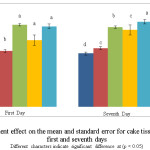 |
Fig.1: The treatment effect on the mean and standard error for cake tissue moisture on the first and seventh days Different characters indicate significant difference at (p < 0.05) |
As shown in Figure 1., the first treatment group included the samples with 50% grape syrup concentrate and more while the second group involved the samples with 25% grape syrup concentrate and less. Accordingly, the results indicated that there was no statistically significant difference between the control groups and the samples with 25% grape syrup, having the least amount of moisture, respectively. In addition, there was no statistically significant difference between the treatments with 100%, 75% and 50% grape syrup, including the maximum level of moisture. On the seventh day, four different treatment groups were observed which were categorized into the first, second, third and fourth control groups with 100, 50, 75 and 25% grape syrup, respectively. In conclusion, there was no significant statistical difference between the treatments with 75% and the treatments with 25% grape syrup.
Generally, there was a significant statistical difference between the first and seventh days in terms of the interaction of the moisture of cake among the different treatments. In fact, one-day time could affect the moisture of cake. During the storage time, a change took place in the moisture value of all treatments, due to an interactional effect. The treatment with 100% grape syrup on the seventh day had the maximum interactional effect during the storage time. The treatment with 25% grape syrup on the first day had the minimum interactional effect during the storage time. The minimum level of changes on the different days belonged to the treatment with 50% grape syrup. Thus, the treatment with 100% grape syrup showed the maximum content of moisture. Therefore, the results indicated that the cakes including this treatment had a greater content of moisture because of lower changes in the firmness and a lower level of staling with respect to the direct effects of moisture changes on the firmness. In this regard, there was scarcity of literature to compare. The results were similar to those of another research.18 However, date powder as sugar replacement in present study. In another study, similar to the results of the present study, the product moisture increased as compared to the control although the replacement of honey for sugar in the Muffin was reported.19 Further, the content of moisture increased after increasing the level of treatment, which it could be attributed to the high absorption of moisture in the treatments.
Protein content
As illustrated in Figure 2, a statistically significant difference was not observed after adding the grape syrup to the 0%, 50% and 100% sample, and the sample with 75% grape syrup indicated a decrease in protein content, compared to the sample with 25% grape j syrup. Therefore, the results were categorized into three different statistical groups: the first group includes the samples with 0%, 50% and 100% grape syrup, and the second and third groups consist of the samples including 25% and 75% grape syrup.
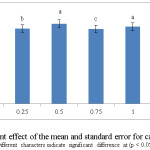 |
Figure 2: The treatment effect of the mean and standard error for cake protein content Different characters indicate significant difference at (p < 0.05) |
A lack of significant difference in the first group of samples is because of the impact of cooking heat, which it partly has damaged the protein profile of grape syrup. The protein content of the grape syrup used in this study was 1.4 gr per 100-gr. Therefore, adding grape syrup in order to make a product with protein content higher than that of control sample failed to increase the protein content of the final product. Results of a research indicated that the protein content was reduced.20 Reduction in protein content may be due to peptide bond hydrolysis, which could cause breakdown of protein molecules with the help of protease enzymes.
Sugar content
Figure 3 illustrates the results of significant difference at the level of 5% in the parameter of sugar. In other words, an increase in the level of grape syrup led to a decrease in the content of sugar. Given that the sugar level in the spongy cake was estimated to be at least 27 (weight percentage based on the dry matter),16 this amount in the control sample was close to the standard level and significantly decreased in other samples since there was a significant statistical difference between the sugar level of the control sample and all other samples.
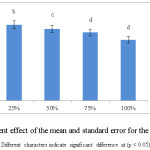 |
Figure 3: The treatment effect of the mean and standard error for the parameter of sugar Different characters indicate significant difference at (p < 0.05) |
Peroxide value of the extracted fat
The standard peroxide value was estimated to be up to 2 mEq.kg, which all samples except for the sample containing 25% grape syrup reported the same standard. As shown in Figure 4, there is a significant difference among all samples at the 5% level while there was no statistical difference between the sample with 75% grape syrup and the control sample. The reason may be due to similarity of the component in both control and 75% grape syrup used in the sponge cake formula.
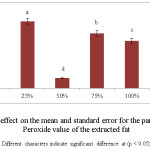 |
Figure 4: The treatment effect on the mean and standard error for the parameter of value of the Peroxide value of the extracted fat Different characters indicate significant difference at (p < 0.05) |
Acidity of extracted fat
The results are depicted in Figure 5. It is evident that there was a statistically significant difference between the samples and the control treatment. In other words, the samples with 25% and 75% grape juice concentrate having no statistical difference were categorized into a same group and the samples with 50% and 100% grape syrup were categorized into a separate statistical group. In addition, there was a statistical difference between these two groups.
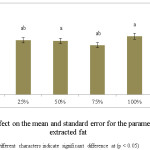 |
Figure 5: The treatment effect on the mean and standard error for the parameter of the acidity of extracted fat Different characters indicate significant difference at (p < 0.05) |
The standard value was estimated to be up to 0.4 (weight percentage) and all samples indicated the same standard.16 The acidity of extracted fat in the 50%-grape juice concentrate sample showed the minimum level, which justified the stopped activity of lactic acid bacteria with respect to grape syrup structure and its antioxidant properties.21 The results obtained from this study were inconsistent with those of the similar study on the replacement of grape juice concentrate in a shortcake.21
Water activity
From Figure 6, the highest water activity was observed in the treatment containing 100% grape syrup and the lowest proportion belonged to the control treatment. The 25%-grape syrup and the 50%-grape syrup treatment were categorized into the same group. That is, these treatments had no effect on the water activity toward another. An increase occurred in the parameter of water activity as the level of grape syrup decreased from 0% to 100% (Figure 6). This value must be up to 0.75 at 25˚C according to the (ISIRI).16 Regarding the results of this study, all samples represented a value higher than this amount, due to the water in the grape syrup.
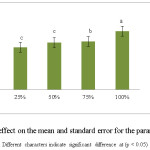 |
Figure 6: The treatment effect on the mean and standard error for the parameter of water activity Different characters indicate significant difference at (p < 0.05) |
The water activity is an appropriate factor to evaluate the shelf life and microbiological stability of food stuffs.22 Therefore, an increase in water activity in the level of grape juice concentrate can lead to a reduced shelf life of the final product, and the mold formation of cakes. These results were consistent with the results obtained from the study on the replacement of date liquid sugar with invert sugar in a layer cake sample with 100% replacement as well as the sample containing 100% grape syrup, because the water activity of sample increased in the aforementioned study through the 100% replacement of treatment, although in the study on the replacement of date liquid sugar with the invert sugar, an increase in the water activity of all samples was not in ascending order and the results for the 100%-grape syrup sample were similar to those of this study.23
pH
As illustrated in Figure 7, the sample with 100% grape juice concentrate indicated the highest level of pH, which was out of the standard range (6-7) in all other samples. In general, there was no significant difference between the control treatment and other groups, which was consistent with the results of the study done by Aqamohammadi et al.,24 on the effect of molasses as a replacement for sugar on the properties such as batter, size and color of shortcake.24 Furthermore, there was no significant difference between the control samples and other samples of batter in the above-mentioned study. The pH level of grape juice concentrate is 4.755.25 According to the results, the pH range of all samples was alkaline and the decreased level of pH can be attributed to the presence of other ingredients including egg white with pH = 9.
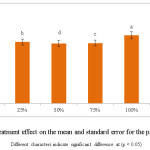 |
Figure 7: The treatment effect on the mean and standard error for the parameter of pH Different characters indicate significant difference at (p < 0.05) |
pH is an important factor in determining the shelf life (the storage time) of final product.26 Therefore, as depicted in Figure 7, the sample with 100% grape juice concentrate had the shortest shelf life.
Acid-insoluble ash
The results of contrast analysis indicated a significant difference (at the 5% level) between the control treatment and other treatments in terms of acid-insoluble ash parameter. The results indicated that the control sample showed the least amount of acid-insoluble ash, compared to the other treatments, in which the amount was increased, compared to the control sample. Since, the grape syrup has many mineral matters, the ash content increases as the grape syrup increases.21
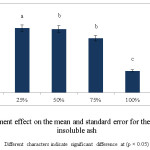 |
Figure 8: The treatment effect on the mean and standard error for the parameter of acid insoluble ash Different characters indicate significant difference at (p < 0.05) |
The standard amount of acid-insoluble ash in spongy cakes must be up to 0.05 (weight percentage based on the dry matter).16 The results indicated that the control sample is in standard limit and the amount of acid-insoluble ash increased in the samples with 25%, 50% and 75% grape syrup by increasing the content of grape syrup.
The results were congruent with a similar study which focused on replacing the sugar with grape juice concentrate in the enriched biscuits. Also, an increase in the content of grape juice concentrate increased the ash content of samples.6
Color of cake
In Table 1, the results of mean comparisons for the parameters L*, b* and a* indicated that the maximum and minimum amount of L* (lightness) belonged to the control and 100% grape syrup treatment on the seventh day, respectively. The amount of parameter L* (lightness) was gradually decreased from the control to the treatment with 100% grape syrup. On the other hand, the minimum and maximum levels of a* (redness) belonged to the control treatment and the treatment with 50% grape syrup on the seventh day, respectively. The parameter a* was gradually increased from the control to the treatment with 75% grape syrup while a decrease took place later. Further, regarding the parameter b* (yellowness), the treatment with 25% grape syrup and the control treatment represented the maximum and minimum level, respectively.
Table 1: Color parameters of cake samples for different levels of grape syrup
|
Seventh Day |
First Day |
Treatment Effect |
Index |
|
a71.81 |
68.52 a |
Control |
L* (Lightness)
|
|
c62.47 |
65.77 b |
25% grape syrup |
|
|
d61.96 |
59.62 c |
50% grape syrup |
|
|
b63.90 |
55.23 e |
75% grape syrup |
|
|
e60.78 |
57.14 d |
100% grape syrup |
|
|
e2.51 |
2.72 e |
Control |
a* (Redness) |
|
c6.76 |
7.2 d |
25% grape syrup |
|
|
a7.52 |
7.83 c |
50% grape syrup |
|
|
d6.65 |
9.57 a |
75% grape syrup |
|
|
b7.24 |
8.56 b |
100% grape syrup |
|
|
e27.34 |
28.28 e |
Control |
b* Yellowness)) |
|
a32.3 |
34.49 a |
25% grape syrup |
|
|
b30.60 |
32.49 d |
50% grape syrup |
|
|
c30.46 |
33.67 b |
75% grape syrup |
|
|
d30.16 |
32.69 c |
100% grape syrup |
In parameter a*, the treatment with 75% grape juice concentrate on the first day and the treatment with 50% grape juice concentrate on the seventh day indicated the maximum level, and the treatments on the first and seventh days in the control treatment showed the minimum level as well. The level of a* in the treatment with 75% grape syrup confirmed an increasing trend, indicating that the color of cake has become darker. Regarding the reason, the existence of high colored ingredients into grape syrup can be mentioned. The results were consistent with those in another study on the shortcake.24 The sucrose was replaced by the molasses in the above-mentioned study. Further, in this study, the cause of darkness of cakes was the existence of high color ingredients in molasses and invert sugar. Furthermore, the level of L* decreased by increasing the content of grape syrup leading to the dark-colored cakes. The results were congruent with those of the study on the replacement of some sweeteners for sucrose.27 In the present study , the level of a* also increased in all treatments as compared to the control treatment, indicating that the cakes have become more brown and this darkness can be made because of the high level of color ingredients into grape syrup. The results of this study are in line with those conducted in Pakistan in 2009. The results of contrast analysis indicated that there is a significant difference (at a probability level of 1%) between the means of control treatment and those of other treatments in terms of the parameters L*, a* and b*.28
Cake sensory evaluation
An increase in the percentage of grape syrup has a great impact on the score resulted from the assessors’ comments. So that, the overall acceptability of cake was increased by increasing the percentage of grape syrup, and the sample with 100% grape syrup also gained the highest level of acceptability by the assessors. The higher rate of acceptability can be related to a better tissue, oral sense and better taste, due to the increased moisture of cake by increasing the content of grape syrup. In addition, the sample with 100% grape syrup indicated the highest rate of acceptability in terms of the color of cake, because of the high level of color ingredients into grape syrup.
Conclusion
The results of this study showed that the formulation prepared with 100% grape syrup had a higher sensory evolution score in terms of overall acceptability and the minimum rate of adhesion. In addition, this treatment revealed the minimum rate of firmness and the maximum content of moisture on the seventh day. Furthermore, the sample with 100% grape syrup can be a suitable replacement for the sugar because it has the lowest amount of sugar, while having a sweet and desired taste. Therefore, the formulation emphasized for the cake containing 100% grape syrup can effectively be used as the replacement for sucrose in order to make a low-calorie spongy cake.
Acknowledgments
This research was supported by Islamic Azad University, National Nutrition & Food Technology Research Institute (NNFTRI), Shahid Beheshti University of Medical Sciences, Tehran, Iran.
Refrences
- Nourmohammadi A, Peyghambardoust H, Oladghafari E, Azadmard damirchi S, Hesari j. Effects of replacement sucrose with polyols and aspartame on the properties of sponge cake. J Food Industry. 2012;21(2):155-165.(Persian).
- Baeva MR, Panchev IN, Terzieva VV. Comparative study of texture of normal and energy reduced sponge cakes. Die Nahrung. 2000;44(4):242-246.
CrossRef - Zoulias EI, Piknis S, Oreopoulou V. Effect of sugar replacement by polyols and acesulfame-K on properties of low-fat cookies. J Science of Food and Agriculture. 2000;80(14):2049-2056.
CrossRef - Pasha I, Butt MS, Anjum FM, Shahzadi N. Effect of dietetic sweeteners on the quality of cookies. International J Agriculture and Biology. 2002;4:245-248.
- Butt MS, Pasha I, Tufail F, Anjum FM. Use of low absorptive sweeteners in cakes. International J Agriculture and Biology. 2002;4(2):249-251.
- Saghari V, Shakouri Sh. The effect of replacing the grape juice concentrate with sugar and biscuits fortified. Second National Conference of Food Science and Technology, Islamic Azad University of Ghouchan, Ghouchan, Iran.(Persian). 2014.
- Aminian M, Abedinia A. The feasibility of replacing the sugar with the juice of grapes in the traditional sweets halva syrup. National Conference on Food, Islamic Azad University of Ghouchan, Ghouchan, Iran. (Persian). 2010.
- Deok-Kun, OH. Tagatose: properties, applications, and biotechnological processes. Appl Microbiol Biotechnol. 2007;76(1):1-8.
CrossRef - Shourideh M, Taslimi A, Azizi MH. Mohamadifar MA, Mashayekh M. The use of D- tagatose impact, inulin and stevia as an alternative to sucrose on some physical properties, chemical, rheological and sensory properties of dark chocolate. Iranian J Nutrition Sciences and Food Technology. 2011;3:29-38(Persian).
- Dobbs KM, Bell LB. Storage stability of tagatose in buffer solutions of various compositions. Food Research International. 2010;43(1)382-386.
CrossRef - Levin, G. V.: Tagatose, the new GRAS sweetener and health product. J Medical Food. 2002;5(1):23-36.
CrossRef - Katherine J, Luecke K. Thermal stability of Tagatose in solution. J Food Science. 2009;4:346-351.
- Lemus RM, Vega-Gálvez a, Zura-Bravo L, Ah-Hen, K. Stevia Rebaudiana Bertoni, source of a high-potency natural sweetener. J Food Chemistry. 2012;132:1121-1132.
CrossRef - AACC, Approved Method of the American Association of Cereal Chemists. St. Paul, American Associations of Cereal Chemists, Ins. 1999.
- ISIRI, Measurement Method Cereal´s Raw Protein and their Products. Iran´s National Standard No. 2863 (3rd Version). Institute of Standards and Industrial Research of Iran, Karaj, Iran. 2007.
- ISIRI, Cake- features and test methods, Iran´s National Standard No. 2553 (3rd Version). Institude of Standards and Industrial research of Iran, Karaj, Iran. 2007.
- ISIRI, Biscuit features, Iran´s National Standard No. 37 (3rd Version). Institute of Standards and Industrial research of Iran, Karaj, Iran. 2007.
- Azadmard damirchi S, Zarei P. Effect of different values of date syrup on shelf life and quantitative and qualitative properties of sponge cake. Iran Biosystems Engineering 2016;46(4)399-404. (Persian).
- Strait MJ. The effect of liquid or dry honey as a partial replacement for sugar on the baking and keeping qualities of fat reduced Muffins. M. Sc. thesis. Blacksburg, Virginia. 1997.
- Maleki k, Mirzaee H, Fadavi A. Using of pumpkin powder in cake producing and evaluation some physicochemical and microbial properties of cake containing Pumpkin powder. J Food Science and Technology. 2016;61(13):183-193. (Persian).
- Asiaban F, Baei MT. Effect of different values of grape juice concentrate on quantity and quality properties of Shortcake. Second National Conference of Optimization Supply chain, Distribution, Consumption in Food Industry, Sari, Iran. (Persian). 2015.
- Winkelhausen E, Jovanovic-Malinovska R, Velickova E, Kuzmanova S Sensory and microbiological quality of a baked product containing xylitol as an alternative sweetener. International J Food Properties. 2007;10(3)639-649.
CrossRef - Ahmadi Gavlighi H, Azizi MH, Jahanian L, Amirkavoei S. Effect of replacement of date liquid sugar with invert sugar in layer cake. J Food Science and Technology. 2010;8(1)57-64:(Persian).
- Aghamohammadi B, Honarvar M, Ghiasi Tarzi B, Delkhosh B. The Effects of Using Molasses as a Replacement for Sugar on physical and biochemical and sensory properties of Shortenedcake. J Food Technology and Nutrition. 2014;3:15-22:(Persian).
- Tavakolipour H, Kalbasi A. Process of rheological features of grape juice concentrate. J Food Science and Technology. 2014;40(10)129-137:(Persian).
- Jay, J. M.; Modern Food Microbiology, Aspen Publishers. 2000;39-56.
- Mohabati M, Azizi MH. Replacement some sweeteners of sucrose in low-calorie sponge cake. M. Sc. Thesis, Tarbiat Moderess University, Tehran, Iran. 2014. (Persian).
- Akesowan A. Quality of reduced-fat chiffon cakes prepared with erythritol-sucralose as replacement for sugar. Pakistan J Nutrition. 2009;8(9):1383-1386.
CrossRef.

This work is licensed under a Creative Commons Attribution 4.0 International License.





